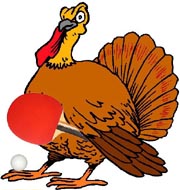Tactics versus Strategy
I've blogged in the past about the difference between tactical and strategic thinking. Tactical thinking is what you do to win now; strategic thinking is what you do to prepare yourself to win later. I had an experience a while back where I was coaching a junior against another junior who was about the same level. The other junior was a better counterlooper, while the one I was coaching had a better block. It went into the fifth game. Between games I said, "Do you want to counterloop with this guy?" (I was thinking he should block more, since they were getting into a lot of counterlooping points.) The junior I was coaching said, "I can beat him counterlooping."
My first thought was that if you block, you'll win, but if you counterloop you'll lose. I opened my mouth, then closed it, and then realized this was one of those strategic moments. So we worked out a tactical plan whereby he'd not just counterloop, but he'd serve and receive to get into those rallies. Because he was looking to counterloop every chance, he was ready for the shot, and so was able to pull out the fifth game, counterlooping down an opponent who normally would have won most of those rallies. It was a huge confidence booster for him, and he improved dramatically as his game became more looping, less blocking. Tactically, blocking might have been the right thing to do, but strategically, he needed to be able to counterloop against this type of player if he wanted to reach the higher levels, and so counterlooping was the strategic choice.
How to be more aggressive with third-ball attack


 Photo by Donna Sakai
Photo by Donna Sakai





